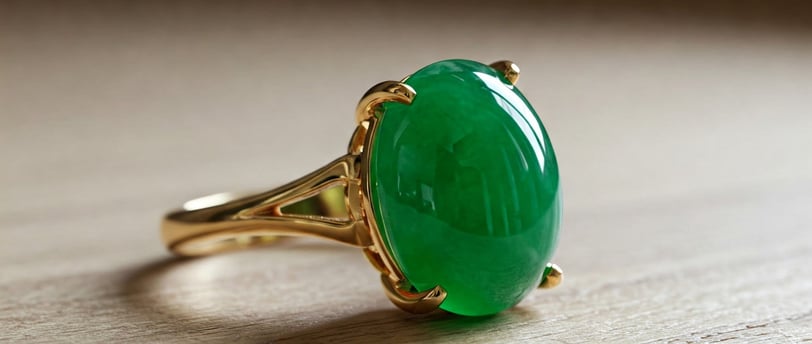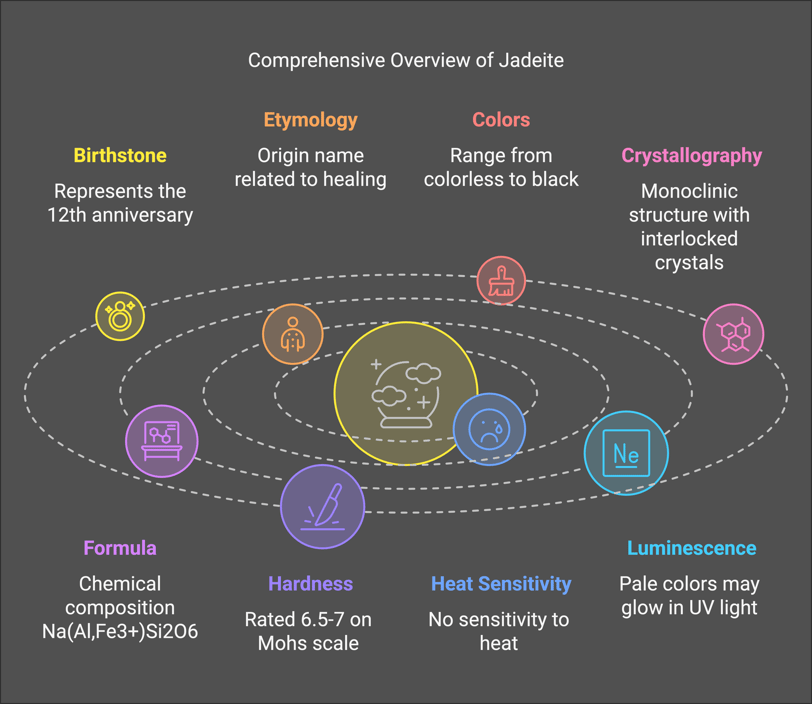Jade
Jade: Explore the 'Stone of Heaven' – its history, mineral origins, and how to assess its quality. Learn about enhancements, simulants, and buying tips for this treasured gemstone.
1/30/20254 min read


History
Jade, often called the "Stone of Heaven", boasts an elegance unmatched by any other gem. This precious stone has been used for centuries, not just for its beauty but also for its toughness, making it suitable for tools and even musical instruments. Its cultural roots trace back to prehistoric times, with Stone Age people using it for weapons, tools, ornaments, and ritual objects. The Chinese have especially treasured jade, viewing it as a gemstone of royalty and a link between the spiritual and material worlds. In Central America, ancient civilisations like the Olmecs, Aztecs, Mayans, and Toltecs also prized jade, using it for currency, ceremonial pieces, and religious relics. The Portuguese introduced jade to Europe from China, believing it could cure kidney ailments. This rich history and cultural significance make jade a truly remarkable gemstone.
Mineral Origins
The term "jade" actually refers to two distinct minerals: jadeite and nephrite. While both are considered jade, they have different compositions and properties. Jadeite is a pyroxene mineral and is generally rarer, harder, and more expensive. Nephrite is an amphibole mineral and is known for its exceptional toughness. Both minerals are incredibly durable and resistant to wear, although nephrite is slightly tougher. Jadeite's most valuable colour, imperial green, is not found in nephrite. Jadeite typically occurs as a sodium-aluminum silicate rock with a polycrystalline structure. In addition to jadeite and nephrite, green omphacite can also be considered jade under certain conditions.
The 4 C’s
Colour
Colour is the most important factor in determining the value of jade. While jade is available in many colours, green hues are the most popular and valuable. The most desirable colour is a vivid, pure green known as "imperial jade". This colour, called "cui" in Chinese, is a determining factor for top-quality jade. Imperial jade is a pure green, balanced between blue and yellow hues, without the slight blue tint seen in top emeralds. Other notable green varieties include "apple green" and "flower green," a mottled variety with bright, dark, and light greens. Besides green, jadeite can be found in lavender, colourless "ice" jade, yellow, black, and white. Lavender is the second most valuable colour, followed by ice jade. Red jade, usually found in outer rinds of boulders, and yellow jade, often with orange hues, are also available, though less common. Black jade, actually a dark-toned green, is also used in jewellery. Blue jade, very rare, is mainly found in Guatemala and has strong green hues. Pink jade is not natural as a primary hue and is usually dyed or an imitation. The distribution of colour also affects value, with rare specimens exhibiting three or more vivid hues commanding higher prices.
Clarity
While ideally jade should be eye-clean, it often has inclusions. Inclusions that impair the stone's translucency reduce its value. However, silky tube-like inclusions can enhance beauty, and attractive coloured inclusions in white stones may raise their price. Black inclusions visible to the eye reduce jade prices due to their association with bad luck in Chinese culture. Any fractures, even internal ones, also lower prices because of jade's association with strength and durability.
Carat
Jade is generally priced by the piece, rather than per carat, although top-quality material of even 5 carats can be quite valuable. For jadeite, the value of cabochons, beads, and bangles increases with size, assuming all other quality factors are equal. The value of jadeite increases more dramatically with size than nephrite.
Cut
Jade is commonly cut into cabochons, especially for high-quality material. The preferred cut is an oval double cabochon with a moderately domed top and a smaller domed bottom. Some cabochons are hollowed out to improve transparency and reduce price. The Chinese "bi", a disk with a hole in the middle, is another popular shape for jade, as well as linked loops. Round beads are another common form, with long strands and larger beads being especially valuable due to colour-matching difficulties. Jade bangles are also highly prized, especially those made from a single piece of rough jade, known as hololiths. Carved jade pieces are common but often made from lower quality material.
Be Aware Of
Enhancements
Jade treatments are widespread due to its popularity. Three "types" of treatments are used. Type A jade is untreated, possibly with a wax coating. Type B jade is soaked in acid and impregnated with polymer to improve transparency and texture. This can drastically reduce toughness, and it will only be worth approximately 5-10% of an equivalent untreated stone. Type C jade is dyed. Often, dye is used with polymer impregnation, creating "Type B+C" jade. Red jade is sometimes heat-treated, which results in a permanent reddish-brown colour. It is difficult to tell if jade is untreated by looking at it, so obtaining a laboratory report is essential for any major purchase.
Simulants
Many materials are used to imitate jade. Common simulants include glass, dyed quartz, chalcedony, serpentine, soapstone, prehnite, idocrase, and maw sit sit. Hydrogrossular garnet is a particularly convincing simulant, and other stones like carnelian, zoisite, calcite, and jasper can simulate different colours of jade. Some jade imitations may even have marketing names that include "jade," which are misnomers.
Synthetics
General Electric has successfully synthesized jadeite in the laboratory, with properties similar to natural stones, but differences in visible light and infrared absorption spectra. These synthetic jadeites are not commercially available.
Final Thoughts
Buying Tips
When buying jade, remember that colour is the most significant value factor, especially bright, pure green. Translucency and texture also play important roles. Always obtain a laboratory report to ensure that the jade is natural and to check for any treatments. Buy from a trusted dealer with a return policy. Be aware of imitations and treatments, as these can significantly reduce value. Consider the cut and size, as well as the artistry and antiquity, if purchasing carved pieces.
Jewelry Care
Both jadeite and nephrite are durable and tough. Clean your jade jewellery with warm, soapy water and a soft cloth or brush. Avoid harsh chemicals and mechanical cleaning if your jade has been treated. To keep your jade looking its best, remove it before sleeping. With proper care, jade can be worn daily and passed down through generations while maintaining its original appearance.


Gemius Stones
Expertise
© 2025. All rights reserved.
